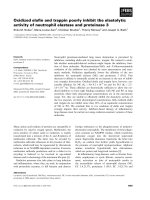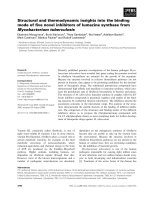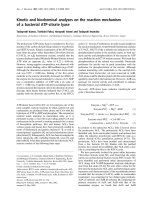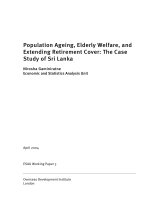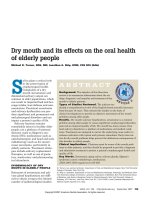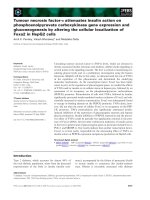Low blood albumin and cholesterol levels affecting the conception rate of cross bred cows with ovsynch protocol
Bạn đang xem bản rút gọn của tài liệu. Xem và tải ngay bản đầy đủ của tài liệu tại đây (209.77 KB, 6 trang )
Int.J.Curr.Microbiol.App.Sci (2020) 9(8): 3249-3254
International Journal of Current Microbiology and Applied Sciences
ISSN: 2319-7706 Volume 9 Number 8 (2020)
Journal homepage:
Original Research Article
/>
Low Blood Albumin and Cholesterol Levels Affecting the Conception Rate
of Cross Bred Cows with Ovsynch Protocol
D. Sengupta1 and S.K. Sheetal2*
Department of Veterinary Gynaecology and Obstetrics, Bihar Veterinary College,
Bihar Animal Sciences University, Patna, Bihar, India
*Corresponding author
ABSTRACT
Keywords
Cholesterol,
Albumin,
Progesterone,
Conception rate,
Ovsynch protocol
Article Info
Accepted:
24 July 2020
Available Online:
10 August 2020
This study was undertaken to evaluate the effect of serum albumin and cholesterol level on
the conception rate with Ovsynch protocol in cross-bred cattle. Fifty cross-bred cows were
selected and divided into two groups- low albumin cholesterol (LAC; <3 mg/dl albumin
and 150 mg/dl cholesterol) and high albumin cholesterol group (HAC; > 3.5 mg/dl
albumin and 220 mg/dl cholesterol). The conception rate of LAC and HAC was 10% and
38% respectively that differed significantly (P<0.05). Return to heat on or before day 22
was significantly higher in LAC (60.7%) compared to HAC (32.3%). Pregnant cows of
LAC group (n=5) had significantly higher albumin and cholesterol level (3.4±0.04 mg/dl
and 194.78±3.75 mg/dl respectively) than their non-pregnant counterpart (3.29±0.01 mg/dl
and 146.99±1.44 mg/dl respectively; n=30). On days 12, 14, 16 and 18 the progesterone
concentration of non-pregnant cows of LAC group (2.9±0.04 ng/ml, 2.1±0.03ng/ml,
1.8±0.03ng/ml, 0.7±0.01 ng/ml respectively) was significantly lower than day 65 pregnant
cows of HAC group (5.2±0.08 ng/ml, 4.7±0.11ng/ml, 5.3±0.09 ng/ml, 5.7±0.07 ng/ml
respectively).From the results it can be inferred that low cholesterol and albumin level
directly decreases the blood progesterone level and initiates early luteolysis, both are
instrumental in early embryonic death and low conception rate with Ovsynch protocol.
Since blood cholesterol is the main precursor for the synthesis of progesterone by the
corpus luteum and 90% of progesterone in blood is bound to albumin, their deficiency
directly affects the blood progesterone level. Blood albumin and cholesterol should always
be checked and corrected before the start of Ovsynch protocol.
Introduction
Large dairy farms are on the rise in India
wherein one of the most important factors
limiting reproductive performance of dairy
cows is heat detection. Traditional methods of
heat detection are inefficiently applied on
large dairy herds due to less number of
laborers deployed for this task per cow.
Moreover cows exhibit different degree of
secondary signs of heat and most of the estrus
detection in these farms is based on these
secondary signs. According to recent studies,
less than 50% of the lactating dairy cows
3249
Int.J.Curr.Microbiol.App.Sci (2020) 9(8): 3249-3254
were detected in estrus (Washburn et al.,
2002), resulting in prolonged interinsemination intervals and less profit for the
dairy producers.
One way to solve this problem is to control
follicular dynamics so as to make all cows
ovulate at a fixed time thus eliminating the
need of estrus detection. Ovsynch protocol
(injection of GnRH 7 days before and 48
hours after PGF2α) is one such protocol that
facilitates synchronization of follicular
development, luteal regression and time of
ovulation with minimal need of estrus
detection (Pursley et al., 1997a,b). However,
great variations in conception rate have been
reported with Ovsynch protocol (Stevenson et
al., 1999 and Jobst et al., 2000).
We have therefore sought to find out whether
difference in serum biochemistry specially
albumin and cholesterol affects the
conception rate with Ovsynch protocol.
Cholesterol and albumin level in the blood is
mainly controlled by the level of nutrition and
liver function. Since there are degrees of
negative energy balance especially in high
yielder cross-bred cattle, level of these two
biochemical parameters varies greatly.
Cholesterol being the precursor for the
synthesis of progesterone by the corpus
luteum (Stoccoet al.,2005, Roostaeeet
al.,2008) and albumin being the carrier of
progesterone in the blood (Harrison et al.,
1987) might regulate the level of circulating
progesterone which might affect the
conception rate. This work has therefore been
taken up to test these effects.
Materials and Methods
Normal cycling cross-bred cows (n=50) from
farms in and around Patna were tested for
blood albumin and cholesterol level and were
divided into two groups of fifty each. Group
A (n=50) had blood albumin and cholesterol
level below 3 mg/dl and 150 mg/dl
respectively (low albumin cholesterol group;
LAC). Group B had normal blood albumin
and cholesterol level i.e. above 3.5 mg/dl and
220 mg/dl respectively (high albumin
cholesterol group; HAC). These cows were
administered 500 µg cloprostenol sodium
(Pragma®, Intas, India) intra-muscularly on
tenth day of estrous. Ovsynch protocol was
started from the thirteenth day with intramuscular dose of 20 microgram buserelin
acetate (Gynarich®, Intas, India), 500 µg
cloprostenol sodium on day 20 and 20
microgram Buserelin acetate on day 22. All
cows were inseminated twelve hours after the
administration of last dose of buserelin
acetate.
Cows returning to heat on or before day 22
and cows found pregnant on day 65 was noted
and percentage calculated.
Blood samples were collected on day 12, 14,
16 and 18 of AI (day 0). Serum was separated
and stored at -20º C until use. Serum samples
of cows returning to heat on or before day 22
in LAC group and found pregnant on day 65
in HAC group were assayed for progesterone
by ELISA kit (Biogenix, India) following
manufacturer’s protocol.
Data was analyzed by t-test or chi-square test
using SPSS software version 17.
Results and Discussion
Ovsynch protocol in low and high serum
albumin-cholesterol groups of cross-bred
cows resulted in conception rate of 10% (5
out of 50 inseminated cows) and 38% (19 out
of 50 inseminated cows) respectively that
differed significantly (table 1). Among the
non-pregnant cows of low and high serum
albumin-cholesterol group of cows, the
percentage of cows those returned to heat on
or before day 22 of insemination was 60.7%
3250
Int.J.Curr.Microbiol.App.Sci (2020) 9(8): 3249-3254
and 32.3% respectively that differed
significantly (table 2). Amongst cows in low
serum albumin-cholesterol group, the cows
those were found pregnant had significantly
greater albumin and cholesterol level than
those returned to heat on or before day 22
(Figure 2). The progesterone level of cows
those returned to heat on or before day 20 in
the low albumin-cholesterol group was
significantly lower on day 12, 14, 16 and 18
than compared to those found pregnant on day
65 in the high albumin-progesterone group
(Figure 1).
The conception rate of cows with Ovsynch
protocol in high albumin-cholesterol group
was above that reported by Chebel and Santos
(2010)but below Machado et al., (2017);
(25% and 38.4% respectively). However the
conception rate of cows in the low albumincholesterol group in our work was 10% that is
significantly lower than those reported by the
aforementioned workers. This suggests that
serum albumin and cholesterol concentration
is one of the factors responsible for variation
in conception rate with Ovsynch protocol.
Cholesterol is transported to the bovine ovary
by the high density lipoproteins (HDL) and
up-taken by the luteal cells for the synthesis
of progesterone (Stocco et al., 2005, Roostaee
et al., 2008). Cholesterol is metabolised and
converted by the small and large luteal cells
into progesterone. Almost 90% of the
cholesterol used for the synthesis of
progesterone is derived from the blood
circulation in the form of HDL and only 10%
is synthesised by the luteal cells (Harrison et
al., 1987). This explains the low blood
progesterone level in cows of low albuminchlolesterol group in our experiment. Further
90% of the synthesised progesterone is
circulated in the blood bound to albumin and
10% remains free (Harrison et al., 1987).
Thus hypo-albuminemia leads to further
lowering of circulating progesterone.
Looking at the blood progesterone profile of
cows between day 12 to 18 of insemination in
the low albumin-cholesterol group (figure1), a
declining trend can be appreciated that could
be due to pre-mature release of endometrial
PGF2α. It has been reported that in-adequate
exposure of the bovine uterus to progesterone
leads to pre-mature release of endometrial
PGF2α due to early up-regulation of oxytocin
receptors (OTRs) (Demmers et al., 2001).
Lack of progesterone pre-exposure leading to
pre-mature luteolysis is further supported by
the fact that first post-partum heats are often
followed by short estrous cycles (Perea and
Keith, 2007). Thus the cause of early
embryonic death in the low albumincholesterol group can be explained by the low
level of circulating progesterone and
premature release of PGF2α and early return to
heat.
Table.1 Chi square analysis of low blood albumin and cholesterol level affecting the conception
rate of cross bred cows with OvSynch Protocol
Pregnant
Non-pregnant
Significance
Low Blood Albumin
High Blood Albumin
Cholesterol Level1
Cholesterol Level2
5 (10%)
19 (38%)
45 (90%)
31 (62%)
P<0.01
1: blood albumin and cholesterol level below 3 mg/dl and 150 mg/dl respectively
2: blood albumin and cholesterol level above 3.5 mg/dl and 220 mg/dl respectively
3251
Int.J.Curr.Microbiol.App.Sci (2020) 9(8): 3249-3254
Table.2 Chi square analysis of non-pregnant cows with low and high blood albumin cholesterol
level those returned to heat on or before day 22 of insemination (RH22) or found non-pregnant
on day 65 post insemination (NP65)
RH22
NP65
Significance
Low Blood Albumin
Cholesterol Level1
30 (60.7%)
15 (39.3%)
P<0.01
High Blood Albumin
Cholesterol Level2
10 (32.3%)
21 (67.7%)
Figure.1 Blood progesterone level of cows during day 12 to 18 post insemination with low blood
albumin cholesterol level those returned to heat before day 20 (n=15) and cows with high blood
albumin cholesterol level those found pregnant on day 65 (n=15)
**: P<0.01
Figure.2 Difference in blood albumin and cholesterol level among pregnant (n=5) and nonpregnant (n=30) group of cross-bred cows those had general hypo albuminemia (<3 mg/dl) and
cholesterolemia (<150 mg/dl)
A.
B.
*
*
*: P<0.05
3252
Int.J.Curr.Microbiol.App.Sci (2020) 9(8): 3249-3254
Hypo-albuminemia and hypo-cholesterolemia
are very common in cattle post-partum due
low feed intake, high milk yield, negative
energy balance and sub-clinical fatty liver
(Mostaghni and Askari, 1996) and subclinical forms of haemo-protozoan infection
like carrier state of theileriosis (Saberet
al.,2008) that is wide-spread in field
conditions. One of the reasons for the
variation in conception rate reported with
Ovsynch protocol (Chebel and Santos, 2010
and Machado et al., 2017) could be the
variable degree of hypo-albuminemia and
hypo-cholesterolemia that was not studied by
those workers. Our findings point to the fact
that failure of conception in cows with hypoalbuminemia and hypo-cholesterolemia could
be due to low level of circulating
progesterone or might be due to early onset of
luteolysis in these cows. This is further
supported by the fact that amongst the low
albumin-cholesterol group in our work, those
found pregnant had higher level of albumin
and cholesterol compared to cows those
returned to heat on or before day 20.
In conclusion, low blood albumin and
cholesterol level lowers blood progesterone
level and conception rate with Ovsynch
protocol in cross-bred cows. Therefore cows
should be monitored for blood albumin and
cholesterol level before the start of Ovsynch
protocol.
References
Chebel, R. C. and Santos, J. E. P. (2010).
Effect of inseminating cows in estrus
following a presynchronization protocol
on
reproductive
and
lactation
performances. J. Dairy Sci.93:4632–
4643.
Demmers, K. J., Derecka, K. and Flint, A.
(2001). Trophoblast interferon and
pregnancy. J. Reprod. 121: 41-49.
Harrison, N. L., Majewska, M. D.,
Harrington, J .W and Barker, J .L.
(1987). Structure-activity relationships
for steroid interaction with the gammaaminobutyric acid A receptor complex.
J. Pharmacol. Exp. Ther. 241(1) 346353.
Jobst, S. M., Nebel, R. L., McGilliard, M.
L.and Peizer. K. D. (2000). Evaluation
of reproductive performance in lactating
dairy cows with prostaglandin F2α,
gonadotropin-releasing hormone and
timed artificial insemination. J. Dairy
Sci. 83: 2366–2372.
Mostaghni, K. and M. Askari. (1996).
Changes in serum albumin, cholesterol
and
glucose
concentrations
in
subclinical fatty liver syndrome in dairy
cattle. Journal of Applied Animal
Research10(1): 33-38.
Machado, V. S., Neves, R., Lima, F. S. and
Bichalo, R. C. (2017). The effect of
Presynch-Ovsynch protocol with or
without estrus detection on reproductive
performance by parity, and the longterm effect of these different
management
strategies
on
milk
production, reproduction, health and
survivability
of
dairy
cows.
Theriogenology93: 84-92.
Perea, F. G., Keith, I. E. (2007). Infertility
associated with the duration of luteal
phase in postpartum cows. ISSN 10221301. Assoc. Latin. Amer. Prod. Anim.
16(3): 175- 185.
Pursley, J. R., Kosorok, M. R. and Wiltbank,
M.
R.
(1997a).
Reproductive
management of lactating dairy cows
using synchronization of ovulation. J.
Dairy Sci.80:301–306.
Pursley, J. R., Wiltbank, M. C., Stevenson, J.
S., Ottobre, J. S., Garverick, H.A. and
Anderson., L. L.(1997b). Pregnancy
rates per artificial insemination for cows
and
heifers
inseminated
at
asynchronized
ovulation
or
synchronized
estrus.
J.
Dairy
3253
Int.J.Curr.Microbiol.App.Sci (2020) 9(8): 3249-3254
Sci.80:295–300.
Roostaee, A., Barbar, E., Lehoux, J. G.,
Lavigne, P. (2008). Cholesterol binding
is a prerequisite for the activity of the
steroidogenic acute regulatory protein
(StAR). Biochem. J. 412(3): 553-562.
Saber, A. P. R., Khorrami, M. and Nouri, M.
(2008). Evaluation of Haematochemical
Parameters
in
Crossbred
Cattle
Naturally Infected with Theileria
annulata in Iran. Int. J. Dairy Sci.3:
205-209.
Stevenson, J. S., Kobayashi, Y.and
Thompson, K.E. (1999). Reproductive
performance of dairy cows in various
programmed
breeding
systems
including Ovsynch and combinations of
gonadotropin releasing hormone and
prostaglandin F2α. J. Dairy Sci.82:506–
515.
Stocco, D. M., Wang, X. J. Y., Manna, P. R.
(2005). Multiple signalling pathways
regulating
steroidogenesis
and
steroidogenic acute regulatory protein
expression: more complicated than we
thought. Mol. Endocrinol. 19(11):
2647–2659.
Washburn, S. P., Silvia, W. J., Brown, C. H.,
McDaniel, B. T. and McAllister, A. J.
(2002).
Trends
in
reproductive
performance in southeastern Holstein
and Jersey DHI herds. J. Dairy
Sci.85:244–251.
How to cite this article:
Sengupta, D. and Sheetal, S.K. 2020. Low Blood Albumin and Cholesterol Levels Affecting
the Conception Rate of Cross Bred Cows with Ovsynch Protocol. Int.J.Curr.Microbiol.App.Sci.
9(08): 3249-3254. doi: />
3254



